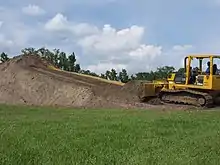
Small dozer forming soil stockpile
A soil stockpile is formed with excavated topsoil during the construction of buildings or infrastructure. It is considered to be an important resource in construction and ecology.[1][2] Soil is stockpiled for later use in landscaping or restoration of the region following the removal of construction infrastructure.[3] Prior to re-use, stockpiled soil may be tested for contamination.[4][5]
References
- ↑ Desiree Rivera; Berta M. Jáuregui; Begoña Pecoa (2012). "The fate of herbaceous seeds during topsoil stockpiling: Restoration potential of seed banks" (PDF). Ecological Engineering. Elsevier. 44: 94–101. doi:10.1016/j.ecoleng.2012.03.005.
- ↑ Peter J. Golos; Kingsley W. Dixon; Todd E. Erickson (25 May 2016). "Plant recruitment from the soil seed bank depends on topsoil stockpile age, height, and storage history in an arid environment". Restoration Ecology. Wiley. 24 (S2): S53–S61. doi:10.1111/rec.12389.
- ↑ Elke Haege; Simon Leake (18 Jun 2014). Soils for Landscape Development: Selection, Specification and Validation. Csiro Publishing. ISBN 9780643109650.
- ↑ Frank Lame; Ton Honders; Giljam Derksen; Michiel Gadella (2005). "Validated sampling strategy for assessing contaminants in soil stockpiles". Environmental Pollution. Elsevier. 134 (1): 5–11. doi:10.1016/j.envpol.2004.07.013. PMID 15572219.
- ↑ Ken S. Chin; Richard G. Christian; Andrea E. Sewall (2005). "Various Applications of Soil Contaminant Database Developed for the Central Artery/Tunnel Project" (PDF). Soil and Sediment Contamination. Taylor & Francis. 14 (3): 183–210. doi:10.1080/15320380590928285. S2CID 130978226.
This article is issued from Wikipedia. The text is licensed under Creative Commons - Attribution - Sharealike. Additional terms may apply for the media files.